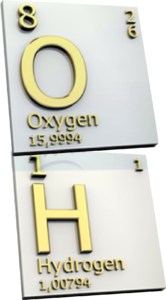
This law links the partial pressure of a gas to its mole-fraction in the liquid phase, and thus declares how much of the gas is dissolved. Henry's Law determines the solubility of gasses in water. How do we determine the solubility of gasses in water? The latent heat of water isĢ250 kJ/ kg at normal pressure and at a temperature of 100 oC. Latent heat is expressed in kilo Joules per kilogram (kJ/kg). When the water cools down the energy is hidden inside the molecule again. It is heat that is hidden in the water molecule and that is used, when water is heated. Latent heat means energy that is absorbed by water molecules, in order to evaporate. The specific heat of water is 4.18 kJ/ kg * oC at 0 oC. The specific heat of a liquid is expressed in kilo Joules per kilogram, per degree Celsius. The relationship between heat and temperature change is usually expressed by the upcoming relationship, where c is the specific heat. The specific heat is the amount of heat per unit mass that is required to raise the temperature of a liquid by one degree Celsius. Thermal properties can be divided up into specific heat and latent heat. Thermal properties of a liquid are properties that have everything to do with heat transfer through this liquid. During evaporation a molecule of water absorbs latent heat. The phase change from liquid to vapour is called evaporation. The molecules are now in the gaseous state this is called water vapour. Due to this absorption of energy the hydrogen bonds connecting water molecules to one another will break. The water molecules in the water absorb that energy individually. To make water evaporate, energy has to be added. In this picture you can see what hydrogen bonds in water look like: Hydrogen bonds can also be formed between atoms of hydrogen and sulphur or nitrogen, typically SH- and NH2- groups. The attraction between hydrogen and oxygen atoms results in a much higher boiling point of water than anticipated for a different molecule with the same mass. The forces holding two molecules together in a hydrogen bond are much stronger than those between molecules and hydrocarbons. These forces of attraction are called hydrogen bonds. The slightly positively charged hydrogen atoms are then attracted to the slightly negatively charged oxygen atoms of other water molecules. As a result the oxygen atom has a slightly negative partial charge and the hydrogen atoms have a slightly positive partial charge.

Hydrogen atoms are attracted to other atoms such as oxygen atoms, because the electrons are pulled closer to the oxygen atom, due to its greater attraction for electrons. The question library on water related issues How are water molecules bond together? Phone: +31 152 610 900 Water Chemistry FAQ Frequently Asked Questions.Separation and Concentration Purification Request.Plant Inspection & Process Optimalisation.Although short-lived and much weaker than the covalent variety, hydrogen bonds contribute significantly to water chemistry because they are extremely abundant in H 2O. Each H 2O can bind to a maximum of four neighbors through these so-called hydrogen bonds. Opposites attract, so this lopsided charge difference allows bonds to form between the hydrogen and oxygen atoms of adjacent H 2O molecules. The area around the oxygen is somewhat negative compared to the opposite, hydrogen-containing end of the molecule, which is slightly positive. Because oxygen and hydrogen attract the shared electrons unequally, each end of the V-shaped H 2O molecule adopts a slightly different charge. Covalent bonds occur when two atoms-in this case oxygen and hydrogen-share electrons with each other. Strong linkages-called covalent bonds-hold together the hydrogen (white) and oxygen (red) atoms of individual H 2O molecules.


Neighboring H 2O molecules interact transiently by way of hydrogen bonds (depicted as blue and white ovals). Individual H 2O molecules are V-shaped, consisting of two hydrogen atoms (depicted in white) attached to the sides of a single oxygen atom (depicted in red). The dynamic interactions of water molecules.


 0 kommentar(er)
0 kommentar(er)
